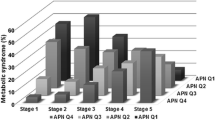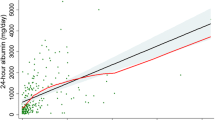Abstract
Background
Experimental studies have shown that adiponectin has antiproteinuric and nephroprotective effects. The purpose of the study was to assess the value of plasma adiponectin as a predictor of proteinuria in type 2 diabetes (T2D) patients.
Methods
In this one-year prospective follow-up study, we included T2D patients with positive visual test for microalbuminuria (Micral) and negative visual test for proteinuria. Exclusion criteria were: glomerular filtration ratio (GFR) < 30 ml/min, acute infection/inflammation, uncontrolled hypertension, and atherosclerotic complications. The main outcome measure was the change in urinary albumin/creatinine ratio (UACR) after 1 year follow-up (Δ UACR).
Results
Fifty-six patients (66% males) completed the study. Their initial mean UACR was 81.58 ± 26.42 mg/g and mean GFR was 81.15 ± 3.96 ml/min. At baseline, simple regression disclosed significant correlations between UACR and plasma adiponectin (r = 0.54, P = 0.00002) and GFR (r = −0.28, P = 0.03); in multiple regression analysis, plasma adiponectin remained the only predictor of UACR (P = 0.00007). Baseline plasma adiponectin was significantly correlated to body mass index (r = −0.28, P = 0.04), waist circumference (r = −0.27, P = 0.05), HDL cholesterol (r = 0.35, P = 0.01), and LDL cholesterol (r = 0.27, P = 0.04). Baseline plasma adiponectin significantly correlated in simple (r = −0.38, P = 0.004) and multiple regression (P = 0.04) to Δ UACR. When patients were divided according to Δ UACR in nonprogressors (Δ UACR < 0) and progressors (Δ UACR > 0), logistic regression showed that baseline GFR (OR = 1.04, CI95%: 1.00–1.09, P = 0.04) and plasma adiponectin (OR = 1.16, CI95%: 1.02–1.32, P = 0.02) were the only factors that predicted whether the patient would be a progressor or not.
Conclusion
In T2D patients, lower plasma adiponectin levels seem to be predictive of increased UACR.

Similar content being viewed by others
References
Jansson PA, Pellmé F, Hammarstedt A et al (2003) A novel cellular marker of insulin resistance and early atherosclerosis in humans is related to impaired fat cell differentiation and low adiponectin. FASEB J 17:1434–1440
Hopkins TA, Ouchi N, Shibata R, Walsh K (2007) Adiponectin actions in the cardiovascular system. Cardiovasc Res 74(1):11–18
Szmitko PE, Teoh H, Stewart DJ, Verma S (2007) Adiponectin and cardiovascular disease: state of the art? Am J Physiol Heart Circ Physiol 292(4):1655–1663
Kadowaki T (2006) Adiponectin and adiponectin receptors in insulin resistance, diabetes and the metabolic syndrome. J Clin Invest 116:1784–1792
Nawrocki AR, Rajala MW, Tomas E et al (2006) Mice lacking adiponectin show decreased hepatic insulin sensitivity and reduced responsiveness to peroxisome proliferator-activated receptor γ agonists. J Biol Chem 281(5):2654–2660
Li S, Shin HJ, Ding EL, van Dam RM (2009) Adiponectin levels and risk of type 2 diabetes: a systematic review and meta-analysis. JAMA 302(2):179–188
Guebre-Egziabher F, Bernhard J, Funahashi T, Hadj-Aissa A, Fouque D (2005) Adiponectin in chronic kidney disease is related more to metabolic disturbances than to decline in renal function. Nephrol DialTransplant 20(1):129–134
Schalkwijk CG, Chaturvedi N, Schram MT, Fuller JH, Stehouwer CD (2006) Adiponectin is inversely associated with renal function in type 1 diabetic patients. J Clin Endocrinol Metab 91(1):129–135
Komaba H, Igaki N, Goto S et al (2006) Increased serum high-molecular-weight complex of adiponectin in type 2 diabetic patients with impaired renal function. Am J Nephrol 26(5):476–482
Norata GD, Baragetti I, Raselli S et al (2010) Plasma adiponectin levels in chronic kidney disease patients: relation with molecular inflammatory profile and metabolic status. Nutr Metab Cardiovasc Dis 20(1):56–63
Barlovic DP, Zaletel J, Prezelj J (2009) Adipocytokines are associated with renal function in patients with normal range glomerular filtration rate and type 2 diabetes. Cytokine 46(1):142–145
Saraheimo M, Forsblom C, Thorn L et al (2005) Serum adiponectin is increased in type 1 diabetic patients with nephropathy. Diabetes Care 28(6):1410–1414
Bakkaloglu SA, Soylemezoglu O, Buyan N et al (2005) High serum adiponectin levels during steroid-responsive nephrotic syndrome relapse. Pediatr Nephrol 20(4):474–477
Shimotomai T, Kakei M, Narita T et al (2005) Enhanced urinary adiponectin excretion in IgA-nephropathy patients with proteinuria. Ren Fail 27(3):323–328
Oguz Y, Yilmaz MI, Acikel C et al (2009) The relationship between adiponectin levels and degree of proteinuria in patients with nephrotic and nonnephrotic proteinuria. Ren Fail 31(1):29–35
Ohashi K, Iwatani H, Kihara S et al (2007) Exacerbation of albuminuria and renal fibrosis in subtotal renal ablation model of adiponectin-knockout mice. Arterioscler Thromb Vasc Biol 27(9):1910–1917
Sharma K, Ramachandrarao S, Qiu G et al (2008) Adiponectin regulates albuminuria and podocyte function in mice. J Clin Invest 118(5):1645–1656
Matsuzawa Y (2010) Establishment of a concept of visceral fat syndrome and discovery of adiponectin. Proc Jpn Acad Ser B Phys Biol Sci 86(2):131–141
Arita Y, Kihara S, Ouchi N et al (1999) Paradoxical decrease of an adipose-specific protein, adiponectin, in obesity. Biochem Biophys Res Commun 257:79–83
Zoccali C, Mallamaci F, Tripepi G et al (2002) Adiponectin, metabolic risk factors, and cardiovascular events among patients with end-stage renal disease. J Am Soc Nephrol 13:134–141
Ramos LF, Shintani A, Himmelfarb J, Ikizler TA (2009) Determinants of plasma adiponectin levels in nondiabetic subjects with moderate to severe chronic kidney disease. J Ren Nutr 19(3):197–203
Hotta K, Funahashi T, Arita Y et al (2000) Plasma concentrations of a novel, adipose-specific protein, adiponectin, in type 2 diabetic patients. Arterioscler Thromb Vasc Biol 20(6):1595–1599
Looker HC, Krakoff J, Funahashi T et al (2004) Adiponectin concentrations are influenced by renal function and diabetes duration in Pima Indians with type 2 diabetes. J Clin Endocrinol Metab 89(8):4010–4017
Gottsäter A, Szelag B, Kangro M, Wroblewski M, Sundkvist G (2004) Plasma adiponectin and serum advanced glycated end-products increase and plasma lipid concentrations decrease with increasing duration of type 2 diabetes. Eur J Endocrinol 151(3):361–366
Lin J, Hu FB, Curhan G (2007) Serum adiponectin and renal dysfunction in men with type 2 diabetes. Diabetes Care 30(2):239–244
Kollerits B, Fliser D, Heid IM, Ritz E, Kronenberg F (2007) Gender-specific association of adiponectin as a predictor of progression of chronic kidney disease: the mild to moderate kidney disease study. Kidney Int 71(12):1279–1286
Jorsal A, Tarnow L, Frystyk J et al (2008) Serum adiponectin predicts all-cause mortality and end stage renal disease in patients with type I diabetes and diabetic nephropathy. Kidney Int 74(5):649–654
Menon V, Li L, Wang X et al (2006) Adiponectin and mortality in patients with chronic kidney disease. J Am Soc Nephrol 17(9):2599–2606
Zoccali C, Mallamaci F (2007) Adiponectin and renal disease progression: another epidemiologic conundrum? Kidney Int 71(12):1195–1197
Zoccali C, Mallamaci F (2011) Adiponectin and leptin in chronic kidney disease: causal factors or mere risk markers? J Ren Nutr 21(1):87–91
Stenvinkel P (2011) Adiponectin in chronic kidney disease: a complex and context sensitive clinical situation. J Ren Nutr 21(1):82–86
Acknowledgments
This work was funded by CNCSIS Romania Idei 1167/2008 grant.
Author information
Authors and Affiliations
Corresponding author
Rights and permissions
About this article
Cite this article
Kacso, I., Lenghel, A., Bondor, C.I. et al. Low plasma adiponectin levels predict increased urinary albumin/creatinine ratio in type 2 diabetes patients. Int Urol Nephrol 44, 1151–1157 (2012). https://doi.org/10.1007/s11255-011-0064-1
Received:
Accepted:
Published:
Issue Date:
DOI: https://doi.org/10.1007/s11255-011-0064-1




